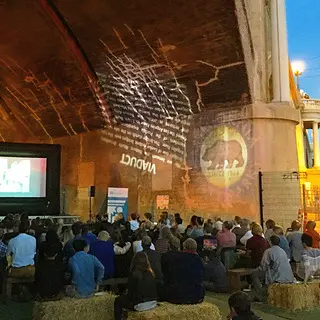
On Film: Los Angeles' LGBTQ History
At a glance, these three Los Angeles buildings look nondescript—completely unremarkable. One is a bar in a blocky white building on Sunset Boulevard in Silver Lake. Another is a U-shaped Spanish Colonial Revival building in a leafy, four-acre park that spans Vista Street, between Santa Monica Boulevard and Fountain Avenue in West Hollywood. Then there’s a three-story brick building on North Spring Street in Chinatown.
But each of these buildings holds a remarkable history. And their stories are told in a new short film series by the Los Angeles Conservancy, LGBTQ Historic Places in L.A. Funded in part by a grant from the Richard and Julia Moe Family Fund of the National Trust and released in partnership with local television station KCET, the three-part series debuted earlier this year.
“This is a way to shine the spotlight on places that are largely unknown, or in some cases forgotten,” says Adrian Scott Fine, director of advocacy at the Los Angeles Conservancy.
Using first-person interviews, photos, and archival material, the films tell the history and significance of these three different sites.
One film explores the history of The Black Cat in Silver Lake, a working-class gay bar that opened in a 1939 Art Deco building in the 1960s.
Just after midnight on January 1, 1967, eight undercover police officers raided the bar, beating patrons and dragging them into the street. In response, local activists organized a demonstration. Hundreds of people gathered outside The Black Cat on February 11, 1967, in what was one of the earliest known demonstrations in support of LGBTQ civil rights.
Another film features Plummer Park in West Hollywood, which opened in 1938.
From 1987 to 1996, the Los Angeles chapter of advocacy group AIDS Coalition to Unleash Power, or ACT UP, held its meetings in the park’s Great Hall/Long Hall at the height of the HIV/AIDS epidemic. The group campaigned for greater visibility and more effective treatment for the disease, and played a huge role in getting the federal government to respond to the crisis through new research and healthcare programs.
The Los Angeles Conservancy also turned its lens on The Woman’s Building in Chinatown.
Built in 1914 for the Standard Oil Company, the Beaux Arts building was The Woman’s Building, a public space for female artists, from 1975 until 1991. Artist Judy Chicago, art historian Arlene Raven, and graphic designer Sheila Levrant de Bretteville founded the Feminist Studio Workshop, the first independent art school for women, which was eventually headquartered there. For nearly two decades, The Woman’s Building was an experimental space for lesbian and feminist culture, with organized programs, activities and artist groups.
Choosing which three sites to feature was like “choosing among your children,” Fine says.
The Los Angeles Conservancy recently completed a fundraising campaign to expand the series and tell the story of at least one other site, if not more.
“Some of these places are starting to become threatened, or they’re closing down, or they’re under development pressure,” Fine says. This film series is a way to memorialize the significance of these places and, Fine hopes, broaden awareness of the LGBTQ story in greater Los Angeles.
To learn more about these places, and to share your story, visit the Los Angeles Conservancy’s website Curating the City: LGBTQ History in L.A.



